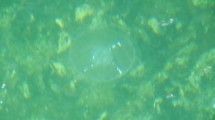Summary
-
1.
A repertoire of five probing motor acts (PMAs) is used by Marcusenius cyprinoides in the exploratory behaviour of novel objects, introduced into the fish's surroundings: chin probing, ‘va et vient,’ lateral probing, tangential probing, and stationary probing.
-
2.
Four of these PMAs are displayed at a defined distance from the object: 6.8±0.4 cm for a metallic rod and 3.1±0.5 cm for a porous porcelain tube.
-
3.
The exploratory behaviour is accompanied by the appearance of a characteristic electric organ discharge activity mode in the interpulse interval histogram. This pattern is typically emitted during va et vient, but occurs also during other acts of exploratory behaviour.
-
4.
The results indicate that PMAs are probably used to reproducably determine the conductivity characteristics of an object.
Similar content being viewed by others
References
Bauer, R.: High electrical discharge frequency during aggressive behaviour in a mormyrid fish, Gnathonemus petersii. Experientia 28, 669 (1972)
Belbenoit, P.: Conditionnement instrumental de l'électroperception chez Gnathonemus petersii. Z. vergl. Physiol. 67, 192–204 (1970a)
Belbenoit, P.: Détermination de la distance maximale d'électroperception des objets chez les Mormyridés. J. Physiol. (Paris) [Suppl. 3] 62, 344 (1970b)
Belbenoit, P.: Relations entre la motricité et la décharge électrique chez les Mormyridae (Teleostei). J. Physiol. (Paris) 65, 197A (1972)
Bell, C.C., Myers, J.P., Russell, C.J.: Electric organ discharge patterns during dominance related behavioral displays in Gnathonemus petersii (Mormyridae). J. comp. Physiol. 92, 201–228 (1974)
Dijkgraaf, S.: The functioning and significance of the lateral line organs. Biol. Rev. 38, 51–105 (1963)
Harde, W.: Nachweis aktiver elektrischer Ortung bei Mormyriden. Z. Tierpsychol. 30, 94–102 (1972)
Heiligenberg, W.: Theoretical and experimental approaches to spatial aspects of electrolocation. J. comp. Physiol. 103, 247–272 (1975)
Heiligenberg, W.: Electrolocation and jamming avoidance in the mormyrid fish Brienomyrus. J. comp. Physiol. 109, 357–372 (1976)
Kramer, B.: Electric organ discharge interaction during interspecific agonistic behaviour in freely swimming mormyrid fish. A method to evaluate two (or more) simultaneous time series of events with a digital analyser. J. comp. Physiol. 93, 203–235 (1974)
Kramer, B.: The attack frequency of Gnathonemus petersii towards electrically silent (denervated) and intact conspecifics, and towards another mormyrid (Brienomyrus niger). Behav. Ecol. Sociobiol. 1, 425–446 (1976)
Kramer, B., Bauer, R.: Agonistic behaviour and electric signalling in a mormyrid fish, Gnathonemus petersii. Behav. Ecol. Sociobiol. 1, 45–61 (1976)
Lissmann, H.W.: On the function and evolution of electric organs in fish. J. Exp. Biol. 35, 156–191 (1958)
Lissmann, H.W., Machin, K.E.: The mechanism of object location in Gymnarchus niloticus and similar fish. J. Exp. Biol. 35, 451–486 (1958)
Moller, P.: ‘Communication’ in weakly electric fish, Gnathonemus niger (Mormyridae). I. Variation of electric organ discharge (EOD) frequency elicited by controlled electric stimuli. Anim. Behav. 18, 768–786 (1970)
Moller, P.: Electric signals and schooling behaviour in a weakly electric fish, Marcusenius cyprinoides L. (Mormyriformes). Science 193, 697–699 (1976)
Moller, P., Bauer, R.: ‘Communication’ in weakly electric fish, Gnathonemus petersii (Mormyridae), II. Interaction of electric organ discharge activities of two fish. Anim. Behav. 21, 501–512 (1973)
Russell, C.J., Myers, J.P.: Bell, C.C.: The echo response in Gnathonemus petersii (Mormyridae). J. comp. Physiol. 92, 181–200 (1974)
Schlegel, P.A.: Activities of rhombencephalic units in Mormyrid fish. Exp. Brain Res. 19, 300–313 (1974)
Szabo, T., Fessard, A.: Le fonctionnement des électrorécepteurs étudié chez les Mormyres. J. Physiol. (Paris) 57, 343–360 (1965)
Szabo, T., Fessard, A.: Physiology of electroreceptors. In: Handbook of sensory physiology, Vol. I/3. Fessard, A. (ed.), pp. 59–124. Berlin, Heidelberg, New York: Springer 1974
Szabo, T., Hagiwara, S.: A latency-change mechanism involved in sensory coding of electric fish (Mormyrids). Physiol. Behav. 2, 331–335 (1967)
Author information
Authors and Affiliations
Additional information
The stay of M.J. Toerring in the C.N.R.S. at Gif-sur-Yvette is supported by a grant of the Dr. Carl Duisberg Foundation, Bad Tölz, West-Germany
Rights and permissions
About this article
Cite this article
Toerring, M.J., Belbenoit, P. Motor programmes and electroreception in mormyrid fish. Behav Ecol Sociobiol 4, 369–379 (1979). https://doi.org/10.1007/BF00303243
Received:
Issue Date:
DOI: https://doi.org/10.1007/BF00303243




